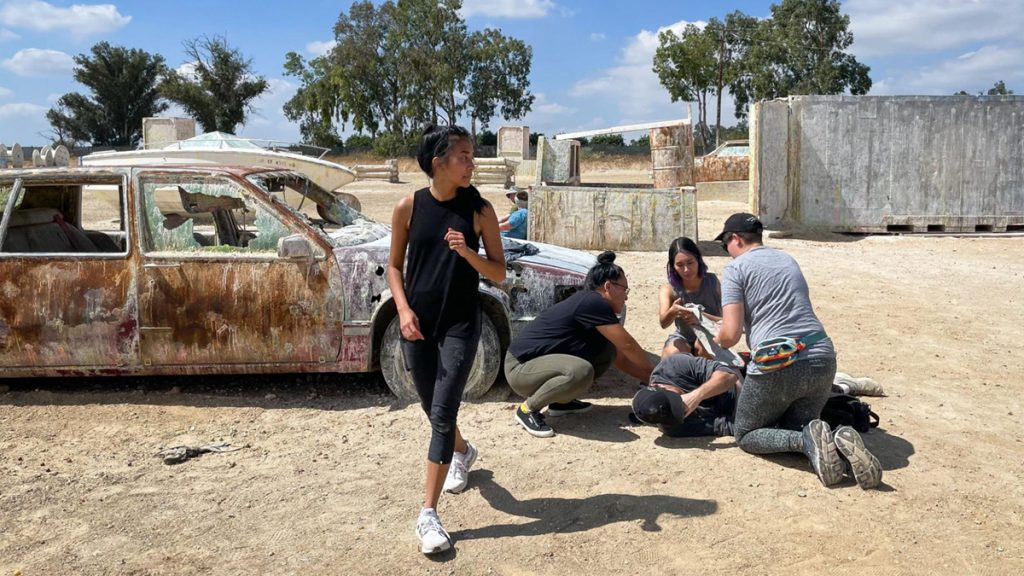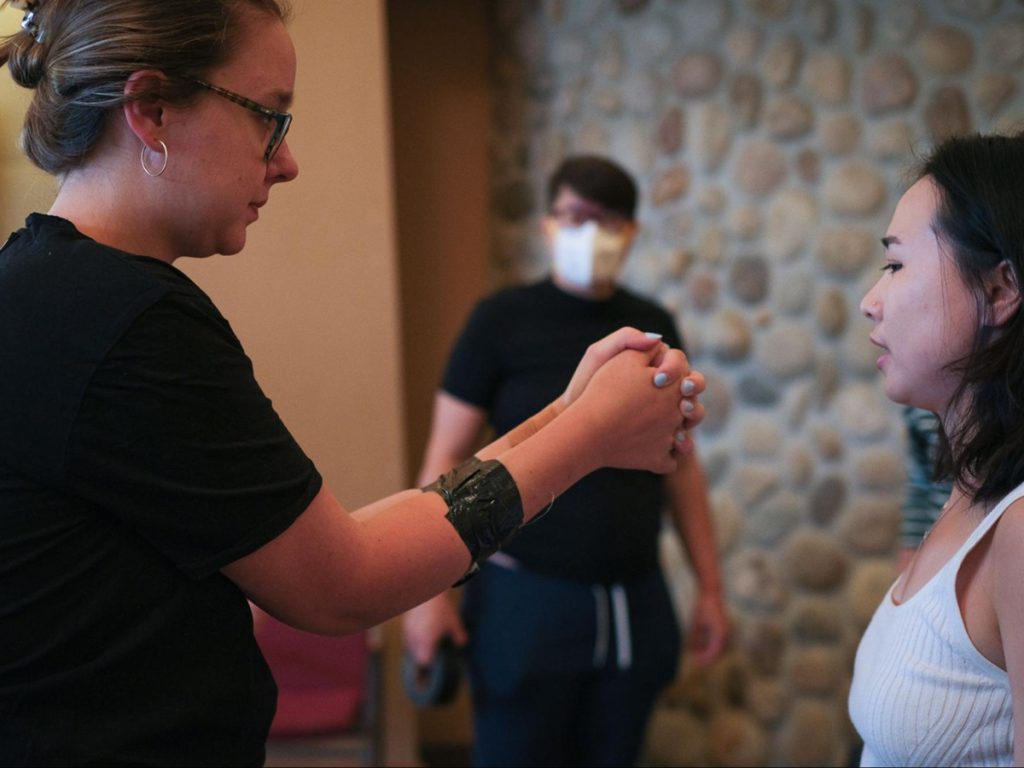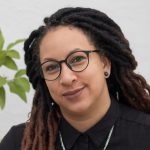
Security training facilitator Rosem Morton leads a first aid scenario during a Sept. 2022 HEFAT offered by IWMF in Los Angeles whose participants were primarily women and nonbinary journalists of color. Photo: Tara Pixley
Resourcing the most marginalized journalists
Why we need identity-aware safety and security training
In the 2022 State of Photography Report supported by Catchlight and the Knight Foundation, a majority of respondents to the survey (88%) said they generally accept risk in their day to day work as photojournalists and editorial photographers.
However, the report further offered that “photographers who identified as female and/or POC, gender-nonconforming, non-binary, transgender and/or people with a disability were disproportionately more likely to indicate that they were ‘not at all confident’ they had received appropriate training and equipment to do their job safely.” I was one of the authors of that report, which represented the experiences of 1,325 photographers surveyed globally, most of them visual journalists. It is statistics on risk and safety like those published in the State of Photography Report that have inspired me to center the needs of journalists from marginalized backgrounds as an integral component of the Journalism Source of Safety (J-SoS) project.
For far too long the safety concerns of journalists of color, women, LGBTQ+, nonbinary and journalists with disabilities have been disregarded to focus on the perceived journalist norm of a white, heteronormative, cis-male body with a passport from a Western nation and a middle-to-upper class background. Those who fall outside those boundaries are often left without the necessary resources and support to do the job of journalism in risky reporting situations.
These limitations and lack of consideration for a multitude of experiences show up in areas like personal protective equipment (PPE) made with a male body in mind — an issue prevalent for women in many professions, including the medical field. Ballistic gear that is not made to adjust its fit for smaller bodies or for people with breasts will not protect its wearer effectively. Limited thinking about journalist identity also appears in how we imagine the safety considerations of journalists who have a uterus or femme-presenting journalists who are statistically far more likely to be sexually assaulted than male journalists. J-SoS takes seriously the necessity of understanding and accounting for journalists’ identities because your safety profile can be greatly impacted by your gender, sexuality, citizenship, race/ethnicity, disabilities and various other aspects of your identity.
J-SoS is not alone in working to elevate the specific safety concerns and resource needs of underrepresented journalists. A 2022 report by UNESCO and the International Center for Journalists (ICFJ) titled The Chilling: Recommendations for action responding to online violence against women journalists highlights increased gendered digital security risks and offers itemized task lists for media organizations, internet companies, civil society organizations, governments and many other entities who can act against this threat to women journalists. In the wake of the 2020 racial injustice protest movement, the National Association of Black Journalists (NABJ) offered a series of resources on coping and self-care specifically for Black journalists.
For far too long the safety concerns of journalists of color, women, LGBTQ+, nonbinary and journalists with disabilities have been disregarded to focus on the perceived journalist norm of a white, heteronormative, cis-male body with a passport from a Western nation and a middle-to-upper class background.
The International Women’s Media Foundation has set out to specifically address the limited safety training and resources available for women and nonbinary journalists. IWMF’s Senior Program Coordinator Maria Alejandra Silva Ortega cites a key acknowledgement the organization has kept in mind since it first started offering HEFATs (Hostile Environment and First Aid Training) six years ago to now: “If you’re a reporter who is a woman or you’re a reporter who is a woman of color or a reporter with a disability who is a woman of color, you have to face all the threats every other reporter has to face plus everything your identity makes unsafe for you.”
After many years producing HEFATs that are trauma-informed and taking participants’ identity under consideration, Silva Ortega has insight into what approaches to training make for a more inclusive experience. “Having a disclaimer is very important so that people know what to expect, such as ‘this training will include pyrotechnics, actors may physically touch you, there might be loud noises’ etc. That really helps everyone but especially any participant who might have trauma or PTSD. You can give participants the option to opt out of certain scenarios if they feel it will be retriggering for them. Having a safe word is important, so that way facilitators know someone needs to step away if they use the safe word. We also keep an eye on the training so that we notice if someone has been less present or stepped away. All of the IWMF facilitators have received some kind of training from a psychologist who specializes in how best to engage a traumatized person. (Traumatized journalists being triggered by safety training) happens all the time in HEFATS, but I don’t know how many trainers or facilitators know how to handle those situations or even have the awareness to see when someone is being affected.”
Additionally, the ways a journalist’s identity might impact their safety profile are often intersectional and not always as easy to recognize as ill-fitting PPE or the dangers of being a Black journalist reporting on a white supremacist rally. PENAmerica and IWMF digital security advisor Mari Galicer says “the way that identity impacts (digital security) is more indirect and structural, things like technical literacy, accessibility and access to technology from a young age.”
Performing the functions of a journalist’s job inherently requires a high level of digital literacy, but Galicer notes access to that technical literacy is often tied up in various types of systemic and structural issues i.e. whether you had a computer at home growing up and learned how to do research at a young age. She cautions against assuming a level of familiarity with systems that might not be the case based on a particular journalist’s background. “There is often an assumption that folks have smartphones or other kinds of devices that make security and privacy practices easier but are really expensive. You can’t make assumptions about what kinds of purchasing power people have for these tools,” says Galicer. This sentiment is echoed in the 2015 UNESCO Report on Building Digital Safety for Journalists that states cost and access are two big challenges journalists face in getting the digisec resources they need.
The origins of HEFATs are situated in response to the Bosnian War and are typically structured with foreign correspondents in mind. Many journalists of color value telling stories closer to home, however, recognizing that important stories are also down the street, not just across borders. This is also true of student journalists and self-taught freelancers who are often focusing on their own communities without the backing of well-resourced news organizations. There are many varied risks to reporters, even those working in their own neighborhoods or elsewhere in their home country and the conceptual prejudice of HEFATs toward conflict zones leaves out key safety tips to that end.

Chicago-based independent visual journalist Sebastián Hidalgo experienced this kind of bias toward his need for safety training early in his career. Hidalgo says he applied to attend HEFATs and other safety training to be prepared for his visual reporting in and around Chicago communities but was consistently denied. He continued his work anyway without access to extensive safety training or resources and saw how the recent period of global pandemic, civil unrest and insurrection made apparent to the U.S. news industry that danger lurks right here at home. “After 2020, after everything that has happened in the last two years, then (journalism safety training programs) started to consider my application as legitimate or that’s what it felt like,” says Hidalgo. “I had been recycling applications, telling the same story over and over again, but this was the first year I’ve been getting accepted so I can’t help but question why.”
When he was able to access safety training, Hidalgo cited first aid components that were very useful but he also saw how the resources were clearly geared toward war zones and didn’t make an effort to legitimize the knowledge he already had. Before having access to a traditional HEFAT or other journalism safety training Hidalgo relied on the personal safety knowledge he’d gained over a lifetime growing up learning situational awareness in Chicago. He says, “it was ingrained in us to be aware of our surroundings, to be conscious of how we dressed, to look out for the rumbling of cars, the screeching of tires, knowing where to go, where not to go.” Hidalgo says this background has consistently kept him safe and helped him navigate documenting protests or neighborhoods with high crime rates.
Like many journalists coming from backgrounds underrepresented in journalism, much of Hidalgo’s safety knowledge has been learned on the job and he wants to see more of that recognized within safety training. Things like thinking about how if “traveling from New York to California as a journalist of color, there are more things we have to consider about our safety. For example, I would recommend only stopping at truck stops and knowing where those are.” He encourages safety training facilitators to collect people’s perspectives, especially those who are deeply ingrained in the communities they cover.
Chicago-based independent visual journalist Sebastián Hidalgo experienced this kind of bias toward his need for safety training early in his career. Hidalgo says he applied to attend HEFATs and other safety training to be prepared for his visual reporting in and around Chicago communities but was consistently denied.
“Not every city is the same, every place is different and I might experience something different than another journalist. We need to listen to people.” Validating and bridging a variety of lived experiences and perspectives would strengthen the knowledge of every journalist taking a safety course. This practice of empowering journalists to share their expertise surviving in myriad environments and responding to risk needs to also come from a trauma-informed standpoint.
Collective healing, Hidalgo says, “needs to also be a part of the safety course program principles: How do you take care of yourself and others when you’re seeing people who look like you die or get hurt? We run the risk of becoming bitter people, unable to establish healthy and constructive relationships. That is something we need to protect against and it is often not a part of safety training and courses. One of the hardest things for anyone to do is to look at an atrocity, for us to speak about them, and not lose ourselves because of it. If we’re able to keep ourselves physically safe, part of that is being mentally secure. If we’re not able to focus because we’re nervous or alienated because of our lived experiences, we won’t be paying attention to our surroundings. In many disenfranchised communities, addressing traumas are met with a range of cultural and systemic roadblocks. It becomes unspeakable or bootstrapped, the worst thing it can possibly become. At least in safety training programs, there is an opportunity for something different.”
While it is imperative to take every individual journalist’s background into consideration when assessing a safety profile, practicing identity-aware and trauma-informed risk management does not mean assuming race, gender, sexuality or other elements of identity are inherently safety risks. In fact, Silva Ortega says there are many ways in which our identity can be a boon for journalists. “Being a woman, someone might underestimate you and that could work to your advantage in some situations,” she says. “I think that piece needs to be included more — that your identity can be empowering, not always something that’s holding you back.”
Resources
As part of my work on Source of Safety, I am offering weekly listening sessions so that journalists around the world can connect with me directly to talk about their experiences with professional hazards, safety concerns and risk management needs. If you’re interested in talking about any element of safety and security for visual journalists, please schedule a meeting with me here.
Take the Safety Survey: Part of this project is trying to assess the safety and risk management needs of visual journalists around the world. Please take this survey to offer your thoughts, experiences and what you want to see taught in journalism safety training!
Follow us on Twitter and share your safety tips, gear and anecdotes from on the ground experiences using #sourceofsafety
I have put together a list of readings and an accessible Google Drive of resources that will be continuously updated over the course of this project and beyond. Please email info@sourceofsafety.org if you have any suggestions for guides, checklists, reports, templates or anything else to add to these living resources.

Comments